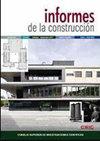现有住宅建筑起火时的安全挑战
IF 0.4
4区 工程技术
Q4 CONSTRUCTION & BUILDING TECHNOLOGY
引用次数: 0
摘要
自20世纪中期以来,在现有住宅建筑中增加楼层(上升)一直是欧洲的普遍做法。在19世纪下半叶和20世纪初,ensanches的城市发展被住宅区占据,在levantes发现了一个机会来支付翻修成本和限制城市分散。然而,实施这些措施的工作面临着开发商、设计师和监管机构的许多挑战,消防安全(SCI)是最令人困惑的问题之一。SCI规范是为新建筑制定的,它们在现有建筑中的使用可能会产生不可预测的结果,甚至可能阻止某些干预措施。本文分析了西班牙SCI规范在电梯中的应用所产生的问题,提出了基于不降低所需安全水平的性能的解决方案。自20世纪中期以来,在现有住宅街区增加地板已成为欧洲的一种广泛做法。城市扩张中的城市发展,在19世纪下半叶和20世纪上半叶被住房街区所占据,在这些增加中发现了一个机会,既可以支付翻修费用,又可以限制城市的扩张。然而,这些工作面临着开发人员、设计师和代码官员面临的许多挑战,其中最令人困惑的是消防安全(FS)。规定消防安全规范适用于新建筑,在现有建筑中使用这些规范可能会产生不可预测的结果,甚至导致一些干预措施变得绝望。本文分析了在地板增补中应用西班牙FS规范性法规所产生的问题,提出了不降低所需安全水平的基于性能的解决方案。本文章由计算机程序翻译,如有差异,请以英文原文为准。
Retos de la seguridad en caso de incendio de levantes en edificios de vivienda existentes
espanolLa adicion de pisos(levantes) en edificios existentes de viviendas ha sido una practica habitual en Europa desde mediados del siglo XX. Los desarrollos urbanos en los ensanches, ocupados por bloques de viviendas en la segunda mitad del siglo XIX y en la primera del XX, encuentran en los levantes una oportunidad para cubrir los costes de renovacion y para limitar la dispersion urbana. Sin embargo, las obras para llevarlos a cabo enfrentan a promotores, disenadores y reguladores a muchos retos, constituyendo la seguridad de incendio (SCI) uno de los mas confusos. Los Codigos prescriptivos de SCI estan redactados para edificios nuevos y su uso en edificios existentes puede tener resultados impredecibles, llegando incluso a imposibilitar determinadas intervenciones. Este articulo analiza la problematica que la aplicacion de la regulacion prescriptiva espanola de SCI genera en los levantes, proponiendo soluciones basadas en prestaciones que no disminuyan el nivel de seguridad requerido. EnglishFloor additions in existing housing blocks have been an extended practice in Europe since the middle of the 20th century. The urban developments in the city expansions, occupied by housing blocks in the second half of the 19th century and the first half of the 20th, find in the additions an opportunity, both to cover the renovation costs and to limit urban sprawl. However, the works to carry them up, face developers, designers and code officials with many challenges, being fire safety (FS) one of the most confusing. Prescriptive Fire Safety Codes are intended for new buildings, and their use in existing ones may have unpredictable results, even making hopeless some interventions. This paper analyses the problematic that the application of the Spanish FS prescriptive regulation generates in floors additions, proposing performance-based solutions that do not diminish the required safety level.
求助全文
通过发布文献求助,成功后即可免费获取论文全文。
去求助
来源期刊

Informes De La Construccion
工程技术-结构与建筑技术
CiteScore
0.90
自引率
16.70%
发文量
49
审稿时长
6-12 weeks
期刊介绍:
Founded in 1948 by the Instituto Técnico de la Construcción y del Cemento, Informes de la Construcción is a scientific journal issued quarterly. Its articles cover fields such as architecture, engineering, public works, environment, building services, rehabilitation, construction systems, testing techniques, results of research on building components and systems and so forth. Journal"s readership includes architects, engineers and construction companies, as well as researchers and professionals engaging in building construction and public works.
 求助内容:
求助内容: 应助结果提醒方式:
应助结果提醒方式:


